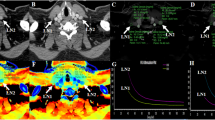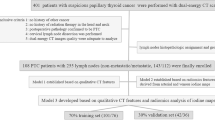Abstract
Objectives
To explore the added value of arterial enhancement fraction (AEF) derived from dual-energy computed tomography CT (DECT) to conventional image features for diagnosing cervical lymph node (LN) metastasis in papillary thyroid cancer (PTC).
Methods
A total of 273 cervical LNs (153 non-metastatic and 120 metastatic) were recruited from 92 patients with PTC. Qualitative image features of LNs were assessed. Both single-energy CT (SECT)–derived AEF (AEFS) and DECT-derived AEF (AEFD) were calculated. Correlation between AEFD and AEFS was determined using Pearson’s correlation coefficient. Multivariate logistic regression analysis with the forward variable selection method was used to build three models (conventional features, conventional features + AEFS, and conventional features + AEFD). Diagnostic performances were evaluated using receiver operating characteristic (ROC) curve analyses.
Results
Abnormal enhancement, calcification, and cystic change were chosen to build model 1 and the model provided moderate diagnostic performance with an area under the ROC curve (AUC) of 0.675. Metastatic LNs demonstrated both significantly higher AEFD (1.14 vs 0.48; p < 0.001) and AEFS (1.08 vs 0.38; p < 0.001) than non-metastatic LNs. AEFD correlated well with AEFS (r = 0.802; p < 0.001), and exhibited comparable performance with AEFS (AUC, 0.867 vs 0.852; p = 0.628). Combining CT image features with AEFS (model 2) and AEFD (model 3) could significantly improve diagnostic performances (AUC, 0.865 vs 0.675; AUC, 0.883 vs 0.675; both p < 0.001).
Conclusions
AEFD correlated well with AEFS, and exhibited comparable performance with AEFS. Integrating qualitative CT image features with both AEFS and AEFD could further improve the ability in diagnosing cervical LN metastasis in PTC.
Clinical relevance statement
Arterial enhancement fraction (AEF) values, especially AEF derived from dual-energy computed tomography, can help to diagnose cervical lymph node metastasis in patients with papillary thyroid cancer, and complement conventional CT image features for improved clinical decision making.
Key Points
• Metastatic cervical lymph nodes (LNs) demonstrated significantly higher arterial enhancement fraction (AEF) derived from dual-energy computed tomography (DECT) and single-energy CT (SECT)–derived AEF (AEFS) than non-metastatic LNs in patients with papillary thyroid cancer.
• DECT-derived AEF (AEFD) correlated significantly with AEFS, and exhibited comparable performance with AEFS.
• Integrating qualitative CT images features with both AEFS and AEFD could further improve the differential ability.





Similar content being viewed by others
Abbreviations
- AEF:
-
Arterial enhancement fraction
- AEFD :
-
DECT-derived AEF
- AEFS :
-
SECT-derived AEF
- AUC:
-
Area under the curve
- CI:
-
Confidence interval
- CT:
-
Computed tomography
- CTDIvol:
-
CT dose index
- DECT:
-
Dual-energy CT
- DLP:
-
Dose-length product
- HU:
-
Hounsfield unit
- ICC:
-
Intraclass correlation coefficient
- ID:
-
Iodine density
- IQR:
-
Interquartile range
- LN:
-
Lymph node
- PTC:
-
Papillary thyroid cancer
- ROC:
-
Receiver operating characteristic
- ROI:
-
Region of interest
- SECT:
-
Single-energy CT
- US:
-
Ultrasonography
- VIF:
-
Variance inflation factor
References
Haugen BR, Alexander EK, Bible KC et al (2016) 2015 American Thyroid Association management guidelines for adult patients with thyroid nodules and differentiated thyroid cancer: The American Thyroid Association Guidelines Task Force on Thyroid Nodules and Differentiated Thyroid Cancer. Thyroid 26:1–133
Shirley LA, Jones NB, Phay JE (2017) The role of central neck lymph node dissection in the management of papillary thyroid cancer. Front Oncol 7:122
Cho SJ, Suh CH, Baek JH, Chung SR, Choi YJ, Lee JH (2019) Diagnostic performance of CT in detection of metastatic cervical lymph nodes in patients with thyroid cancer: a systematic review and meta-analysis. Eur Radiol 29:4635–4647
Yang J, Zhang F, Qiao Y (2022) Diagnostic accuracy of ultrasound, CT and their combination in detecting cervical lymph node metastasis in patients with papillary thyroid cancer: a systematic review and meta-analysis. BMJ Open 12:e051568
Park JE, Lee JH, Ryu KH et al (2017) Improved diagnostic accuracy using arterial phase CT for lateral cervical lymph node metastasis from papillary thyroid cancer. AJNR Am J Neuroradiol 38:782–788
Kim KW, Lee JM, Klotz E et al (2009) Quantitative CT color mapping of the arterial enhancement fraction of the liver to detect hepatocellular carcinoma. Radiology 250:425–434
Lee DH, Lee JM, Klotz E et al (2013) Detection of recurrent hepatocellular carcinoma in cirrhotic liver after transcatheter arterial chemoembolization: value of quantitative color mapping of the arterial enhancement fraction of the liver. Korean J Radiol 14:51–60
Kang SE, Lee JM, Klotz E et al (2011) Quantitative color mapping of the arterial enhancement fraction in patients with diffuse liver disease. AJR Am J Roentgenol 197:876–883
Mahnken AH, Klotz E, Schreiber S et al (2011) Volumetric arterial enhancement fraction predicts tumor recurrence after hepatic radiofrequency ablation of liver metastases: initial results. AJR Am J Roentgenol 196:W573-579
Su GY, Xu XQ, Zhou Y et al (2021) Texture analysis of dual-phase contrast-enhanced CT in the diagnosis of cervical lymph node metastasis in patients with papillary thyroid cancer. Acta Radiol 62:890–896
McCollough CH, Leng S, Yu L, Fletcher JG (2015) Dual- and multi-energy CT: principles, technical approaches, and clinical applications. Radiology 276:637–653
Rajiah P, Parakh A, Kay F, Baruah D, Kambadakone AR, Leng S (2020) Update on Multienergy CT: physics, principles, and applications. Radiographics 40:1284–1308
Baxa J, Vondráková A, Matoušková T et al (2014) Dual-phase dual-energy CT in patients with lung cancer: assessment of the additional value of iodine quantification in lymph node therapy response. Eur Radiol 24:1981–1988
Gao L, Lu X, Wen Q, Hou Y (2021) Added value of spectral parameters for the assessment of lymph node metastasis of lung cancer with dual-layer spectral detector computed tomography. Quant Imaging Med Surg 11:2622–2633
Robbins KT, Clayman G, Levine PA et al (2002) Neck dissection classification update: revisions proposed by the American Head and Neck Society and the American Academy of Otolaryngology-Head and Neck Surgery. Arch Otolaryngol Head Neck Surg 128:751–758
Viera AJ, Garrett JM (2005) Understanding interobserver agreement: the kappa statistic. Fam Med 37:360–363
Koo TK, Li MY (2016) A guideline of selecting and reporting intraclass correlation coefficients for reliability research. J Chiropr Med 15:155–163
Lesack K, Naugler C (2011) An open-source software program for performing Bonferroni and related corrections for multiple comparisons. J Pathol Inform 2:52
Giavarina D (2015) Understanding Bland Altman analysis. Biochem Med (Zagreb) 25:141–151
Swartz MD, Yu RK, Shete S (2008) Finding factors influencing risk: comparing Bayesian stochastic search and standard variable selection methods applied to logistic regression models of cases and controls. Stat Med 27:6158–6174
Zhang Z (2016) Variable selection with stepwise and best subset approaches. Ann Transl Med 4:136
Ostir GV, Uchida T (2000) Logistic regression: a nontechnical review. Am J Phys Med Rehabil 79:565–572
Chen YF, Yabes JG, Brooks MM, Singh S, Weissfeld LA (2015) A likelihood ratio test for nested proportions. Stat Med 34:525–538
O’brien RM (2007) A caution regarding rules of thumb for variance inflation factors. Qual Quant 41:673–690
Mandrekar JN (2010) Receiver operating characteristic curve in diagnostic test assessment. J Thorac Oncol 5:1315–1316
Willard-Mack CL (2006) Normal structure, function, and histology of lymph nodes. Toxicol Pathol 34:409–424
Nathanson SD (2003) Insights into the mechanisms of lymph node metastasis. Cancer 98:413–423
Ji RC (2006) Lymphatic endothelial cells, tumor lymphangiogenesis and metastasis: New insights into intratumoral and peritumoral lymphatics. Cancer Metastasis Rev 25:677–694
Hellbach K, Sterzik A, Sommer W et al (2017) Dual energy CT allows for improved characterization of response to antiangiogenic treatment in patients with metastatic renal cell cancer. Eur Radiol 27:2532–2537
Deniffel D, Sauter A, Dangelmaier J, Fingerle A, Rummeny EJ, Pfeiffer D (2019) Differentiating intrapulmonary metastases from different primary tumors via quantitative dual-energy CT based iodine concentration and conventional CT attenuation. Eur J Radiol 111:6–13
Acknowledgements
We thank LetPub (http://www.letpub.com) for its linguistic assistance.
Funding
This study received funding by the Natural Science Foundation of China (82171928), Natural Science Foundation of Jiangsu Province (BK20201494), and Basic (Natural) Science Foundation of Education Department of Jiangsu Province (22KJB320005).
Author information
Authors and Affiliations
Corresponding authors
Ethics declarations
Guarantor
The scientific guarantor of this publication is Fei-Yun Wu.
Conflict of interest
Xing-Biao Chen is an employee of Philips Healthcare. The remaining authors of this manuscript declare no relationships with any companies whose products or services may be related to the subject matter of the article.
Statistics and biometry
No complex statistical methods were necessary for this paper.
Informed consent
Written informed consent was waived by the Institutional Review Board.
Ethical approval
Institutional Review Board approval was obtained.
Study subjects or cohorts overlap
No.
Methodology
• Retrospective
• Diagnostic or prognostic study
• Performed at one institution
Additional information
Publisher's note
Springer Nature remains neutral with regard to jurisdictional claims in published maps and institutional affiliations.
Supplementary Information
Below is the link to the electronic supplementary material.
Rights and permissions
Springer Nature or its licensor (e.g. a society or other partner) holds exclusive rights to this article under a publishing agreement with the author(s) or other rightsholder(s); author self-archiving of the accepted manuscript version of this article is solely governed by the terms of such publishing agreement and applicable law.
About this article
Cite this article
Zhou, Y., Xu, YK., Geng, D. et al. Added value of arterial enhancement fraction derived from dual-energy computed tomography for preoperative diagnosis of cervical lymph node metastasis in papillary thyroid cancer: initial results. Eur Radiol 34, 1292–1301 (2024). https://doi.org/10.1007/s00330-023-10109-0
Received:
Revised:
Accepted:
Published:
Issue Date:
DOI: https://doi.org/10.1007/s00330-023-10109-0




